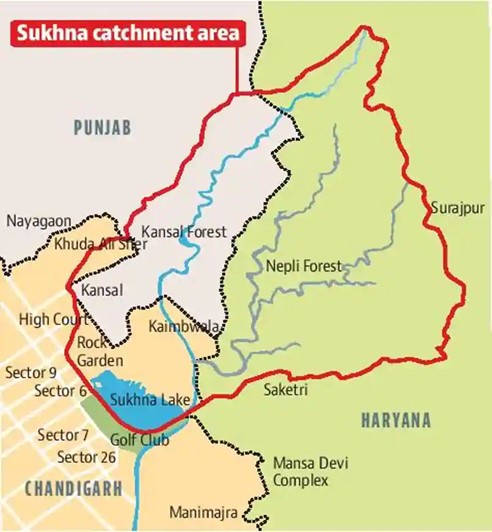Haryana Switch to Hindi
Sukhna Wildlife Sanctuary
Why in News?
Recently, Rejecting the proposal of the Haryana government to delineate an area of 1,000 metres around the Sukhna Wildlife Sanctuary on the Haryana side as an Eco-Sensitive Zone (ESZ), the Union Ministry of Environment, Forest and Climate Change (MoEFCC) has issued a draft notification, demarcating an area of 1 km up to 2.035 km around the Sukhna Wildlife Sanctuary on the Haryana side as an ESZ.
Key Points
- The Sukhna Wildlife Sanctuary, spread over 25.98 square km (about 6420 acres), is under the administrative control of the Union territory of Chandigarh and shares its boundaries with Haryana and Punjab.
- The sanctuary is located in the Shivalik foothills, which are considered ecologically sensitive and geologically unstable.
- It is home to at least seven Schedule 1 animal species of the Wildlife Act, 1972, including leopard, Indian pangolin, sambar, golden jackal, king cobra, python, and monitor lizard.
- The Schedule 1 species are considered endangered and in need of immediate protection.
- Besides, there are Schedule 2 animal species like reptiles, butterflies, trees, shrubs, climbers, herbs, and 250 bird species that inhabit the sanctuary.
Haryana Switch to Hindi
Aravalli Regeneration Plan
Why in News?
Recently, the Delhi forest department has initiated the establishment of a tissue culture laboratory at the Asola-Bhatti Wildlife Sanctuary to conserve rare native trees of Aravalli.
Key Points
- Tissue Culture Laboratory: The lab will be able to extract plant tissue from an in-vitro fully grown plant, generating multiple trees from the same tree.
- The forest department will take assistance from botanists and scientists from the Indian Council of Forestry Research and Education (ICFRE) and the Forest Research Institute (FRI).
- The primary goal of the laboratory is to grow endangered native trees in a controlled environment and regenerate saplings of species facing regeneration challenges due to invasive species.
- Tissue culture has proven highly effective in agriculture, particularly with crops such as bananas, apples, pomegranates, and jatropha, offering higher yields compared to traditional farming methods.
- The Aravalli Plan:
- The regeneration of ridge species like Kulu (ghost tree), palash, doodhi, and dhau is hindered by invasive species, resulting in poor survival rates, with large-scale multiplication achievable only through tissue culture, particularly shoot culture.
- The lab will also be useful in culturing endangered medicinal plants.
Asola Wildlife Sanctuary
- Asola-Bhatti Wildlife Sanctuary is located at the end of an important wildlife corridor that starts from Sariska National Park in Alwar and passes through Mewat, Faridabad and Gurugram districts of Haryana.
- The region has a semiarid climate with notable diurnal temperature variations.
- The vegetation in the Wildlife Sanctuary is predominantly an open canopied thorny scrub. The native plants exhibit xerophytic adaptations such as thorny appendages, and wax-coated, succulent, and tomentose leaves.
- Major wildlife species include Peafowl, Common Woodshrike, Sirkeer Malkoha, Nilgai, Golden Jackals, Spotted deer, etc.








%20MPPCS%202025%20Desktop%20E.jpg)
%20MPPCS%202025%20Mobile%20E%20(1).jpg)










.png)
.png)











 PCS Parikshan
PCS Parikshan


